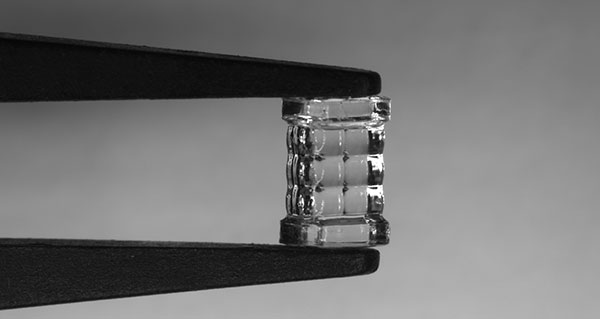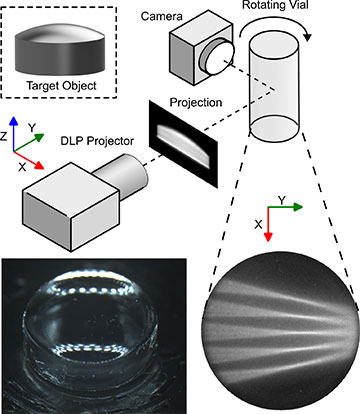
Researchers developed a new 3D-printing method called blurred tomography that can rapidly produce microlenses with commercial-level optical quality. They used the technique to print a microlens array, which is shown being held by a set of tweezers. [Image: Daniel Webber, National Research Council of Canada]
Researchers in Canada have reportedly demonstrated a new blurred-beam technique for 3D-printing millimeter-scale lenses with sharp image quality (Optica, doi: 10.1364/OPTICA.519278). Throwing out the usual requirement of a crisply focused, low-etendue writing beam, the group employed a large-etendue light source that blurred out striations within the small lenses. The researchers used the method, which they dubbed “blurred tomography,” to create a plano-convex lens with optical performance similar to that of a commercial glass lens of the same size.
Volumetric additive manufacturing
The recent growth of additive manufacturing has been a boon to the fabrication of custom optical components, but challenges remain. For example, some types of lenses need support structures to keep them in shape during sequential deposition of material. Tomographic volumetric additive manufacturing (VAM), in which a directed beam solidifies light-sensitive resin into a desired shape, eliminates the need for support structures. But without post-processing steps, the technique leaves striations in the lens material, degrading its optical quality.
A group from the National Research Council of Canada (NRC) solved the VAM conundrum by using a digital light projector with an adjustable-aperture lens to create a high-etendue source of ultraviolet light. The source beamed tomographic projections of the target plano-convex lens shape onto a rotating vial containing photoresin, which added astigmatism and blurring to the light beam. The researchers had to compensate for the short depth of field of the high-etendue beam by computing the tomographic projections with 3D ray-tracing calculations.
The NRC team compared its printed lens, just 3 mm in diameter, with a commercially available glass lens of the same dimensions and found that the pair had comparable image resolution and Michelson contrast. As a further demonstration of blurred tomography’s capabilities, the researchers fabricated two other types of optical components: a microlens array and a ball lens at the end of an optical fiber.

A new technique called blurred tomography employs a custom projection lens to blur the laser beams used to solidify a light-sensitive resin. This produces an optically smooth surface, which allows the printing of commercial-quality lenses, such as the one shown in the bottom left. [Image: Daniel Webber, National Research Council of Canada] [Image: Daniel Webber, National Research Council of Canada]
Faster and cheaper
The researchers say that each of the lenses fabricated with blurred tomography took less than one minute to create, with fewer than 30 minutes of post-processing. By contrast, a roughly similar ball lens took 23 hours to manufacture using two-photon polymerization.
“Blurred tomography can be used to make freeform designs in a low-cost manner,” researcher Daniel Webber said in a press statement. “As the technology matures, it could allow much quicker prototyping for new optical devices, which would be useful for anyone from commercial manufacturers to garage-based inventors.”
The new technique could be used to make other small components such as microfluidic channels and printed arteries, according to the study authors. They are now working to improve accuracy by optimizing the light-patterning method and incorporating material parameters into the printing process, and they hope to make the system suitable for commercial use by introducing automation of the printing time.
